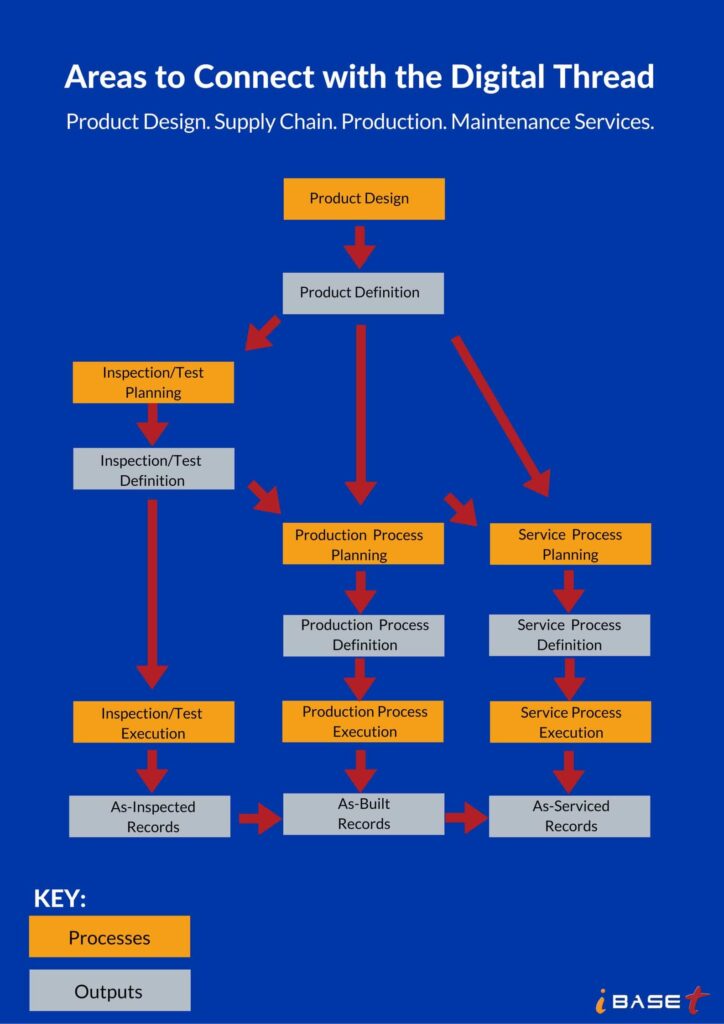We’ve come a long way since products were manufactured by hand. Beginning with the introduction of the PC to the factory floor in the 1970s, computers have revolutionized the manufacturing industry. Factories all over the world have seen concurrent evolution of design and engineering, wherein the development and maturation of computer aided design has created productivity and efficiency gains in manufacturing.
Technical documentation began to evolve from blueprints to 2D drawings and 3D models, and with access to the next generation of software, manufacturing enterprises are now able to optimize the full product life cycle, breaking down corporate silos and enabling the Digital Thread.
Defining the Digital Thread
The Digital Thread integrates design, engineering, manufacturing and MRO (maintenance, repair and overhaul) systems, establishing a seamless flow of information. This type of integration employs data and analytics across the complete product life cycle, optimizing efficiency, from design to manufacturing, operations and maintenance to service in a closed loop. Once the data is analyzed, enterprises are able to see the following:
- Reduction in production losses
- Improved quality
- Efficient use of employees and materials
- Managed production execution for flexibility, repeatability and consistency
The image below represents the handoff of information from Engineer Designs, to Inspection Definition all the way to “As-serviced Records” that flows through the Digital Thread. This chain of information occurs with structured and open communication between systems with little to no manual translation.

Why you MUST Consider Enabling the Digital Thread Today
The Digital Thread is not a “pie-in-the-sky” idea. The technology needed to create this type of environment exists. However, we still find many manufacturing enterprises have not yet started their journey to enabling the digital thread. When enterprises are making a profit, there is a perception they are operating their manufacturing processes efficiently. Even enterprises acquiring 15% EBITDA (Earnings Before Interest, Taxes, Depreciation and Amortization) are still missing out on 3-5 points vanishing due to expenses identified as “cost of doing business.”
Let’s face it, none of us live in a monopoly. We all have competitors, and any day of the week, we could find out our competitor is on their way to delivering a product with higher quality, more options and at a faster time to market. In today’s competitive manufacturing industry if we cannot do things right the first time, or if we cannot react to last minute changes from our customers, our competitors are going to be doing it next week.
Stay ahead of the competition by getting on the Digital Thread.
First Steps Towards Digital Thread Adoption
Beginning the road to creating a Digital Thread within your manufacturing enterprise can seem massive project, especially if you are new to this journey. Below are the steps to begin the foundation of the Digital Thread:
- Analyze your Manufacturing Enterprise’s specific situation:
- Where are you having problems?
- What risks are you experiencing from the market?
- What risks are you experiencing from the technology?
- Identify the first project with a very quick return on investment.
- Establish evolution milestones.
- Nurture new culture around new technology vision.
- Look for support from external suppliers and consultants to help you.
Let’s begin by tackling Step 1 today: Analyze your Manufacturing Enterprise’s specific situation.
Luckily we’ve made this easy for you to do with our Digital Thread Adoption Calculator. In less than three minutes, this calculator will allow you to easily assess where your manufacturing enterprise is as relates to the adoption of the Digital Thread. With a simple A-F grading scale, you’ll be able to easily break down where you can begin your journey to the Digital Thread.





